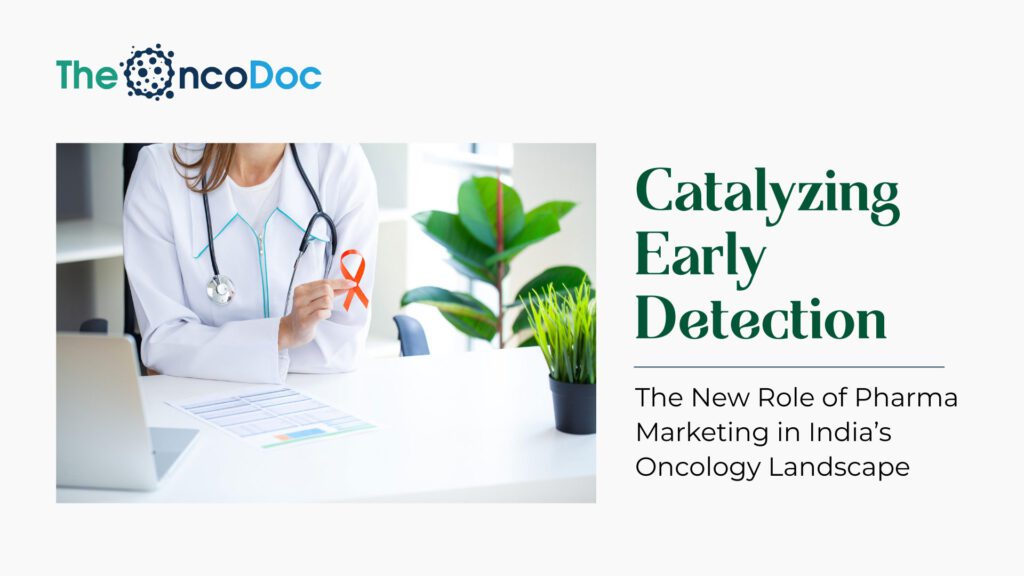Introduction: Expanding the Role of Pharma in Oncology Care Continuum
Traditionally, oncology-focused pharmaceutical marketing has revolved around promoting therapies and treatment regimens to oncologists and specialist care providers. However, the marketing requirement for pharmaceutical companies is quickly changing as India continues to struggle with increased cancer incidence and trends toward late-stage detection.
Today, pharma marketers are increasingly expected to play a proactive role in public health, by driving awareness, improving early diagnosis rates, and supporting timely referrals. This shift doesn’t just align with patient-centric values; it also opens new engagement opportunities for brands aiming to build long-term trust with both healthcare professionals (HCPs) and the public.
According to the National Cancer Registry Programme (NCRP), nearly 70% of cancer cases in India are still diagnosed at advanced stages (Stage III or IV), limiting treatment efficacy and patient survival rates. With digital literacy rising and healthcare information consumption growing in Tier 2 and Tier 3 cities, pharma companies have the power to change this narrative.
This article explores non-AI-based digital and offline marketing strategies that pharma brands can leverage to improve oncology outcomes, moving from product promotion to public health partner.
Section 1: Understanding the Indian Cancer Crisis; A Call to Action for Pharma Marketers
According to the Indian Council of Medical Research’s most recent data, the country is experiencing an increasing cancer problem, with over 1.5 million new cases diagnosed annually (ICMR, 2024). Despite advances in oncology treatments and diagnostics, the country’s 5-year cancer survival rate remains significantly lower compared to many other middle-income nations.
Several critical factors contribute to this alarming trend:
- Limited Public Awareness: A large section of the Indian population remains unaware of basic cancer symptoms, leading to late presentation and diagnosis.
- Delayed Healthcare Seeking Behavior: Cultural stigma, fear, and lack of education often prevent individuals from seeking timely medical advice when early symptoms appear.
- Inefficient Referral Pathways: Many general practitioners and primary care physicians (PCPs), especially in rural and semi-urban regions, lack structured referral mechanisms to guide suspected cancer patients toward oncology specialists.
· Inadequate Access to Screening Facilities: Opportunities for early cancer detection are significantly limited by infrastructure deficiencies in Tier 2 and Tier 3 cities.
Cancer Stage Distribution at Diagnosis in India (2024)
| Cancer Stage | Percentage of Cases |
| Stage I | 8% |
| Stage II | 22% |
| Stage III | 35% |
| Stage IV | 35% |
Source: Indian Council of Medical Research (ICMR), 2024
These statistics serve as a stark reminder of the growing need for pharma marketers to go beyond product promotion. Investing in early-stage awareness campaigns, educational programs for healthcare providers, and community-based outreach can help close critical gaps in India’s cancer care continuum. Addressing these upstream challenges is not just a social responsibility but also a strategic opportunity for pharma brands to become true partners in public health transformation.
Section 2: Targeting General Physicians – The First Line of Cancer Detection
Over 60% of initial cancer consultations in India start with a general physician (GP) or family doctor. This makes PCPs a crucial audience for oncology pharma marketers.
Marketing Tactics for GP Engagement:
- Symptom Recognition Workshops
Organize Continuing Medical Education (CME) programs in partnership with local medical associations focusing on red-flag cancer symptoms. - Printed Symptom Checklists & Referral Flowcharts
Distribute laminated posters, pocket guides, and patient handouts for use in clinics, especially in semi-urban and rural geographies. - WhatsApp and SMS Blasts
Send periodic symptom recognition tips, quiz questions, and diagnostic updates to GP networks. - Medical Journal Advertorials
Run evidence-based cancer symptom advertorials in widely circulated GP journals like the Journal of Family Medicine and Primary Care.
Example Campaign: Breast Cancer Symptom Checklist Drive
- Distributed 25,000 breast cancer awareness pocket cards across Uttar Pradesh’s primary health centers (PHCs)
- Trained 1,200 GPs in self-examination counseling for female patients
- Result: 25% rise in referrals for suspected breast lumps within 3 months
Section 3: Public Awareness Campaigns – From Passive Communication to Active Engagement
While physicians are critical, patient awareness plays an equally pivotal role. According to a 2023 FICCI Healthcare report, only 40% of rural Indians recognize basic cancer warning signs.
Key Public-Facing Strategies:
- Regional Language Radio Campaigns
Both commercial FM stations and All India Radio (AIR) broadcast ailment awareness jingles in regional dialects. - Outdoor Advertising in Cancer Hotspots
Billboards, bus stop signage, and wall paintings in high-incidence districts like Punjab (for lung cancer) and Tamil Nadu (for oral cancer). - Community Outreach through ASHA Workers
Distributing educational leaflets and symptom checklists through Accredited Social Health Activists (ASHAs) in rural belts. - Television Health Segments
Sponsoring weekly cancer awareness slots on popular regional TV channels.

Section 4: Regional Prioritisation – Mapping Campaigns to High-Burden Zones
Not all regions in India face the same cancer types or incidence levels. Customizing campaigns based on epidemiological data is essential.
High-Risk Zones for Specific Cancers:
- Lung Cancer: Maharashtra, Punjab
- Cervical Cancer: Uttar Pradesh, Bihar
- Oral Cancer: West Bengal, Andhra Pradesh
- Breast Cancer: Delhi, Kerala
Pharma marketers should use district-level cancer registry data to plan zonal campaigns.

Source: National Cancer Registry Programme, 2024
Section 5: Partnering with NGOs and Social Enterprises
Collaboration is key for authentic outreach in oncology campaigns.
Partnership Models for Enhanced Oncology Outreach
Building impactful oncology campaigns requires strategic collaborations with organizations already embedded within local communities. Pharma companies can leverage several partnership models to maximize reach and effectiveness:
- Awareness Drives with Cancer Foundations:
Collaborating with reputable organizations like the Indian Cancer Society and CanSupport, pharma brands can co-sponsor village-level awareness camps. These events educate rural populations about common cancer symptoms, risk factors, and the importance of early diagnosis, helping bridge the knowledge gap in underserved areas. - Survivor-Led Storytelling Initiatives:
Pharma marketers can fund community forums and digital storytelling campaigns where cancer survivors openly share their diagnosis, treatment, and recovery journeys. These real-life narratives create emotional resonance, reduce stigma, and encourage others to seek timely medical help. - Screening Camps for High-Risk Groups:
Partnering with local NGOs, pharma brands can organize tobacco cessation programs and oral cancer screening camps, especially in regions with high tobacco use prevalence. - Women-Centric Health Days:
Pharma businesses can provide free gynecological screenings, educational workshops, and counseling services to empower women with knowledge about early detection and access to care by sponsoring breast and cervical cancer awareness days.
Example:
A pharma-NGO cervical cancer awareness partnership in Bihar screened over 15,000 women across 10 districts over a 6-month period in 2024.
Section 6: Oncology-Focused Social Media Campaigns – Creating Digital Behavior Change
While offline engagement matters, digital platforms remain powerful tools for scalable outreach.
Platform-Specific Tactics:
- Facebook:
- Carousel ads explaining symptoms
- Region-specific language targeting
- YouTube:
- Short animated explainer videos on cancer warning signs
- Doctor interviews in vernacular languages
- Instagram:
- Survivor reels and myth-busting stories
- Google Search Ads:
Target people searching for symptoms like “blood in stool” or “breast lump.”
Example: Oral Cancer Awareness Campaign in West Bengal
- Medium: Short video in Bengali explaining oral cancer symptoms
- Reach: 2 million impressions in 3 weeks
- Outcome: 18% increase in OPD footfalls at Kolkata-based cancer centers for oral check-ups
Section 7: Empowering Oncologists as Public Health Advocates
While oncologists primarily engage with patients already diagnosed with cancer, they can play a crucial role in influencing early detection behavior across the healthcare ecosystem. With the right resources and support from pharma companies, oncologists can become trusted voices in promoting awareness and timely referrals.
Pharma-Supported Tools for Oncologists:
- Waiting Room Education Materials:
Pharma companies can provide informative posters, brochures, and leaflets for oncologists to display in clinic waiting areas. These materials can educate patients and caregivers about common cancer symptoms and the benefits of early diagnosis. - Clinic-Based Awareness Events:
Sponsoring dedicated counseling days within oncology clinics can encourage doctors to conduct symptom awareness sessions for patients’ families and visiting caregivers, extending outreach beyond diagnosed patients. - Referral Network Support:
Pharma brands can develop and supply referral directories or physician contact lists, enabling oncologists to guide general practitioners (GPs) and community doctors on where to send suspected cases for further evaluation. - Webinar Series for HCP Education:
Organizing online Continuing Medical Education (CME) webinars, where oncologists discuss early detection strategies with GPs and primary care doctors, can significantly improve referral efficiency and awareness at the primary care level.
Section 8: Using Print Media – The Trusted Channel in Rural Areas
Despite digital growth, print remains a trusted source of health information, especially in rural India.
Print Marketing Tactics:
- Local Language Pamphlets:
Focused on cancer symptoms and when to consult a doctor. - Newspaper Advertorials:
Educational columns placed in widely circulated dailies like Dainik Jagran and Hindustan. - Doctor-Facing Newsletters:
Featuring latest referral guidelines, patient case studies, and early detection checklists.
Example:
A pharma-sponsored series in a Telugu daily on oral cancer signs led to a 20% spike in self-reported symptoms among readers in Andhra Pradesh.
Section 9: Schools and Youth Programs – Building Long-Term Awareness
Inculcating cancer awareness in younger populations can yield multi-generational impact.
Youth-Focused Strategies:
- School Health Talks:
Conduct sessions on oral hygiene, tobacco avoidance, and HPV awareness. - Interactive Quizzes and Competitions:
Promote cancer awareness via inter-school quiz programs, essay contests, or slogan-writing competitions. - Parent Engagement Kits:
Distribute take-home flyers for students’ families on warning signs.
Section 10: Monitoring Impact – The Need for Robust Measurement Frameworks
Campaigns without measurement lose long-term credibility.
Metrics Pharma Should Track:
- Number of referrals generated from GP campaigns
- Engagement rates on digital content (clicks, shares, views)
- OPD footfall increases post-campaign in targeted zones
- Public survey data on symptom awareness shifts
- Screening uptake following community outreach programs

Section 11: Upholding Ethical Standards in Oncology Pharma Marketing
As pharmaceutical companies expand their role into public health advocacy within oncology, maintaining ethical integrity becomes paramount. With campaigns now targeting both healthcare professionals and the general public, clear boundaries between education and promotion are essential.
Key Ethical Guidelines to Adhere To:
- Accuracy in Symptom Communication:
All awareness materials must present factual, evidence-based information. Misrepresentation or exaggeration of symptoms can lead to unnecessary panic or misdiagnosis. - Transparency in Brand Involvement:
Pharma brands must clearly disclose their sponsorship or role in any educational or awareness initiative to avoid misleading audiences about commercial intent. - Separation of Awareness and Product Promotion:
Educational campaigns focusing on early detection must never serve as indirect channels for promoting specific oncology therapies or brands. Any such blending undermines trust and violates ethical norms. - Regulatory Compliance:
All communications must strictly adhere to the guidelines laid out by the Advertising Standards Council of India (ASCI) and the Medical Council of India (MCI). This includes following norms around medical claims, patient data privacy, and promotional content targeting healthcare professionals.
Upholding these ethical standards not only protects patient welfare but also strengthens long-term trust and credibility for pharma brands in the oncology space.
Section 12: Conclusion – Pharma’s Expanding Responsibility in Oncology Public Health
The landscape of oncology pharma marketing in India is undergoing a pivotal transformation. It is no longer sufficient for pharmaceutical companies to focus solely on drug promotion and treatment detailing. Today, there is a growing expectation for brands to play a more meaningful role across the cancer care continuum, starting much earlier in the patient journey.
Pharma marketers are now being called upon to become catalysts for early cancer diagnosis, champions for timely referral pathways, and educators empowering both healthcare professionals and the general public. This expanded responsibility aligns both with patient-centric values and long-term brand credibility.
By adopting multi-channel outreach strategies, combining digital platforms, print media, on-ground activities, and stakeholder partnerships, companies can build regionally relevant and culturally sensitive campaigns. However, such campaigns must remain ethically driven, data-backed, and audience-focused, ensuring that awareness efforts do not blur into therapy promotion.
The true impact of these initiatives goes far beyond commercial gains. When executed responsibly, pharma-led awareness and education campaigns have the potential to improve diagnosis timelines, reduce late-stage presentations, and positively influence survival outcomes for countless cancer patients across India.
Ultimately, the future of oncology pharma marketing is not just about increasing market share, it’s about contributing meaningfully to public health. By becoming trusted partners in India’s fight against cancer, pharma companies can drive both business growth and life-saving outcomes, leaving a lasting legacy of impact.
The Oncodoc team is a group of passionate healthcare and marketing professionals dedicated to delivering accurate, engaging, and impactful content. With expertise across medical research, digital strategy, and clinical communication, the team focuses on empowering healthcare professionals and patients alike. Through evidence-based insights and innovative storytelling, Hidoc aims to bridge the gap between medicine and digital engagement, promoting wellness and informed decision-making.



